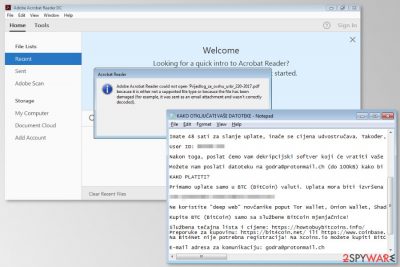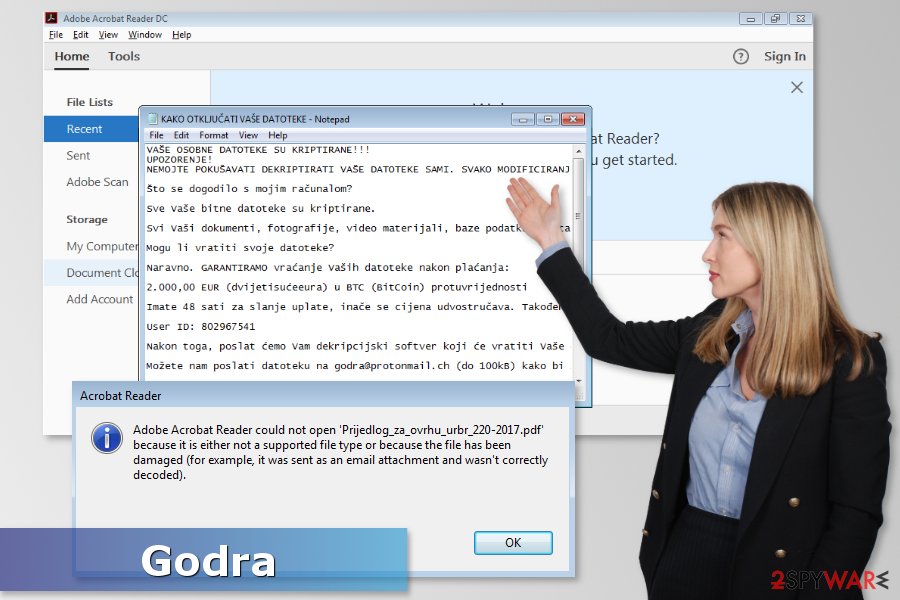Godra ransomware (Free Guide) - Quick Decryption Solution
Godra virus Removal Guide
What is Godra ransomware?
Godra – ransomware that targets Croatian computer users

Godra is a file-encrypting virus that has been noticed spreading in Croatia,[1] in December 2017. Malware affects Windows x64 systems and uses AES cryptography to corrupt files on the targeted device. After the attack, all data is locked with .godra file extension.
Following data encryption, Godra ransomware drops two files on the affected device:
- KAKO OTKLJUČATI Vaše DATOTEKE.txt
- KAKO OTKLJUČATI Vaše DATOTEKE.log
The .log file is responsible for delivering a pop-up notification that informs about data encryption and asks to send an email to godra@protonmail.com. Meanwhile, the .txt file includes a detailed explanation that users have to transfer 2.000 euros in 48 hours to restore files encrypted by Godra virus.
Data recovery instructions also include the link to the Bitcoin wallet address where victims are supposed to send ransoms and unique ID number. Once people make a transaction, they are asked to contact developers of Godra and provide their identification number via mentioned email address.
However, if victims do not pay in two days, the size of the ransom will double. If crooks do not receive the payment within 72 hours, they will delete encrypted files, says the ransom note. In order to give victims guarantee that Godra decryptor exists, criminals allow sending one file (up to 100 KB) for a free decryption.
However, security experts suggest not following these instructions because it may lead not only to data loss but money loss as well. Once you transfer the ransom, crooks might disappear and use your money for further cyber crimes. Instead of risking to increase the damage, you should remove Godra from the PC.
After the attack, you should restart your computer to Safe Mode with Networking and run a full system scan with malware removal software. The reputable program such as FortectIntego can perform Godra removal quickly.

Ransomware spread via malicious emails that pretend to be sent from well-known company Fina
Malware payload spreads as Prijedlog_za_ovrhu_urbr_220-2017.pdf file which is attached to the malicious email. The subject line of these emails are “Elektronička obavijest o pokretanju ovršnog postupka,” (translation to English: “Electronic Notice of Enforcement of Enforcement Procedure”) and they look like sent from Croatian Financial Agency (FINA).
The company released an official statement on their website[2] warning users and customers to be careful. All their sent emails have a domain name fina.hr. Thus, any other endings of the emails are sent by cyber criminals.
However, users who open a malicious attachment, receive a notification from Adobe Acrobat Reader that it is unable to open this file. But opening this file is enough for ransomware to infiltrate the system.
Therefore, Croatian computer users should be cautious and do not rush to click attached .pdf file without checking if it was really sent from the legitimate company. The main signs of the malicious email are:[3]
- grammar or spelling mistakes,
- lack of credentials,
- suspicious email address,
- you do not use FINA's services.
Therefore, before opening an email attachment, you have to check information about the sender online and make sure that it’s actually safe to open.
Elimination of the Godra ransomware virus
To remove Godra from the device, you have to obtain reputable malware removal software. Trying to locate and delete ransomware-related components might lead to irreparable damage to the system. Thus, you have to use automatic virus removal tools.
We recommend FortectIntego or Malwarebytes for Godra removal. However, feel free to use your preferred software as well. However, don’t forget to update it before running a system scan! Additionally, if malware prevents from installing or running security tool, follow the guide below.
Getting rid of Godra virus. Follow these steps
Manual removal using Safe Mode
To enable automatic ransomware removal, follow these steps:
Important! →
Manual removal guide might be too complicated for regular computer users. It requires advanced IT knowledge to be performed correctly (if vital system files are removed or damaged, it might result in full Windows compromise), and it also might take hours to complete. Therefore, we highly advise using the automatic method provided above instead.
Step 1. Access Safe Mode with Networking
Manual malware removal should be best performed in the Safe Mode environment.
Windows 7 / Vista / XP
- Click Start > Shutdown > Restart > OK.
- When your computer becomes active, start pressing F8 button (if that does not work, try F2, F12, Del, etc. – it all depends on your motherboard model) multiple times until you see the Advanced Boot Options window.
- Select Safe Mode with Networking from the list.

Windows 10 / Windows 8
- Right-click on Start button and select Settings.

- Scroll down to pick Update & Security.

- On the left side of the window, pick Recovery.
- Now scroll down to find Advanced Startup section.
- Click Restart now.

- Select Troubleshoot.

- Go to Advanced options.

- Select Startup Settings.

- Press Restart.
- Now press 5 or click 5) Enable Safe Mode with Networking.

Step 2. Shut down suspicious processes
Windows Task Manager is a useful tool that shows all the processes running in the background. If malware is running a process, you need to shut it down:
- Press Ctrl + Shift + Esc on your keyboard to open Windows Task Manager.
- Click on More details.

- Scroll down to Background processes section, and look for anything suspicious.
- Right-click and select Open file location.

- Go back to the process, right-click and pick End Task.

- Delete the contents of the malicious folder.
Step 3. Check program Startup
- Press Ctrl + Shift + Esc on your keyboard to open Windows Task Manager.
- Go to Startup tab.
- Right-click on the suspicious program and pick Disable.

Step 4. Delete virus files
Malware-related files can be found in various places within your computer. Here are instructions that could help you find them:
- Type in Disk Cleanup in Windows search and press Enter.

- Select the drive you want to clean (C: is your main drive by default and is likely to be the one that has malicious files in).
- Scroll through the Files to delete list and select the following:
Temporary Internet Files
Downloads
Recycle Bin
Temporary files - Pick Clean up system files.

- You can also look for other malicious files hidden in the following folders (type these entries in Windows Search and press Enter):
%AppData%
%LocalAppData%
%ProgramData%
%WinDir%
After you are finished, reboot the PC in normal mode.
Remove Godra using System Restore
This method might also help to disable Godra ransomware and perform its automatic removal:]
-
Step 1: Reboot your computer to Safe Mode with Command Prompt
Windows 7 / Vista / XP- Click Start → Shutdown → Restart → OK.
- When your computer becomes active, start pressing F8 multiple times until you see the Advanced Boot Options window.
-
Select Command Prompt from the list

Windows 10 / Windows 8- Press the Power button at the Windows login screen. Now press and hold Shift, which is on your keyboard, and click Restart..
- Now select Troubleshoot → Advanced options → Startup Settings and finally press Restart.
-
Once your computer becomes active, select Enable Safe Mode with Command Prompt in Startup Settings window.

-
Step 2: Restore your system files and settings
-
Once the Command Prompt window shows up, enter cd restore and click Enter.

-
Now type rstrui.exe and press Enter again..

-
When a new window shows up, click Next and select your restore point that is prior the infiltration of Godra. After doing that, click Next.


-
Now click Yes to start system restore.

-
Once the Command Prompt window shows up, enter cd restore and click Enter.
Bonus: Recover your data
Guide which is presented above is supposed to help you remove Godra from your computer. To recover your encrypted files, we recommend using a detailed guide prepared by 2-spyware.com security experts.If your files are encrypted by Godra, you can use several methods to restore them:
Data Recovery pro might help to restore files with .godra extension
Nevertheless, it's not an official decryption software; it might still help to recover some of the corrupted files.
- Download Data Recovery Pro;
- Follow the steps of Data Recovery Setup and install the program on your computer;
- Launch it and scan your computer for files encrypted by Godra ransomware;
- Restore them.
Windows Previous Versions feature helps to access the most important data
This Windows OS feature allows accessing saved files before Godra ransomware attack. However, it allows copying only individual files and under one condition – System Restore had to be enabled before the assault.
- Find an encrypted file you need to restore and right-click on it;
- Select “Properties” and go to “Previous versions” tab;
- Here, check each of available copies of the file in “Folder versions”. You should select the version you want to recover and click “Restore”.
Try ShadowExplorer
If ransomware did not delete Shadow Volume Copies of the targeted files, you can restore files using ShadowExplorer:
- Download Shadow Explorer (http://shadowexplorer.com/);
- Follow a Shadow Explorer Setup Wizard and install this application on your computer;
- Launch the program and go through the drop down menu on the top left corner to select the disk of your encrypted data. Check what folders are there;
- Right-click on the folder you want to restore and select “Export”. You can also select where you want it to be stored.
The official Godra Decryptor is not available yet.
Finally, you should always think about the protection of crypto-ransomwares. In order to protect your computer from Godra and other ransomwares, use a reputable anti-spyware, such as FortectIntego, SpyHunter 5Combo Cleaner or Malwarebytes
How to prevent from getting ransomware
Stream videos without limitations, no matter where you are
There are multiple parties that could find out almost anything about you by checking your online activity. While this is highly unlikely, advertisers and tech companies are constantly tracking you online. The first step to privacy should be a secure browser that focuses on tracker reduction to a minimum.
Even if you employ a secure browser, you will not be able to access websites that are restricted due to local government laws or other reasons. In other words, you may not be able to stream Disney+ or US-based Netflix in some countries. To bypass these restrictions, you can employ a powerful Private Internet Access VPN, which provides dedicated servers for torrenting and streaming, not slowing you down in the process.
Data backups are important – recover your lost files
Ransomware is one of the biggest threats to personal data. Once it is executed on a machine, it launches a sophisticated encryption algorithm that locks all your files, although it does not destroy them. The most common misconception is that anti-malware software can return files to their previous states. This is not true, however, and data remains locked after the malicious payload is deleted.
While regular data backups are the only secure method to recover your files after a ransomware attack, tools such as Data Recovery Pro can also be effective and restore at least some of your lost data.
- ^ Virusi. Virusi. Croatian cyber security news.
- ^ FINA UPOZORAVA NA POJAVU LAŽNIH ELEKTRONIČKIH PORUKA O POKRETANJU OVRŠNOG POSTUPKA TE POZIVA PRIMATELJE DA IH NE OTVARAJU. FINA. The official website.
- ^ Mark Brunelli. Five ways to detect a malicious 'phishing' email. Carbonite. The official Carbonite blog.





















